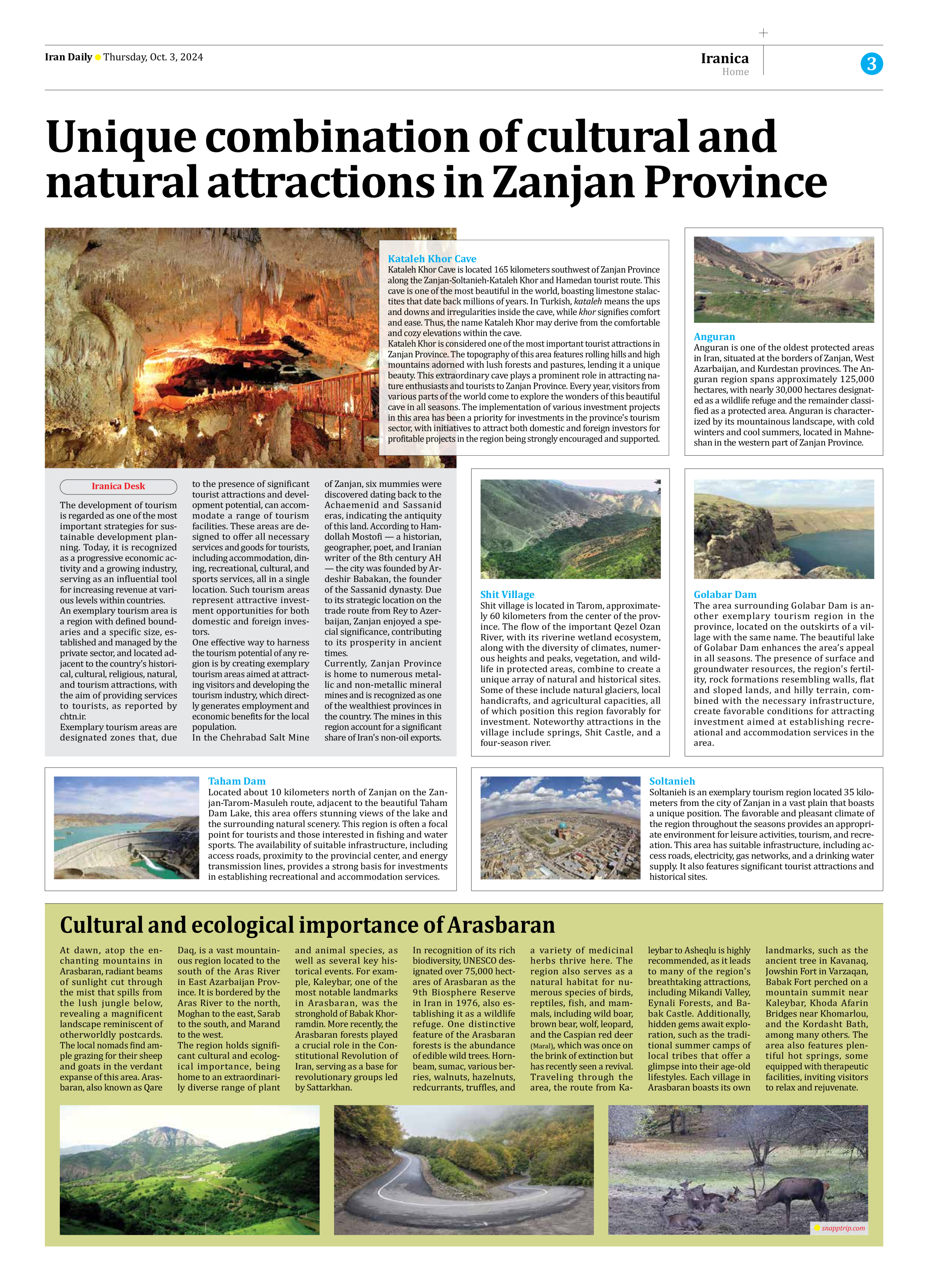
Unique combination of cultural and natural attractions in Zanjan Province
Kataleh Khor Cave
Kataleh Khor Cave is located 165 kilometers southwest of Zanjan Province along the Zanjan-Soltanieh-Kataleh Khor and Hamedan tourist route. This cave is one of the most beautiful in the world, boasting limestone stalactites that date back millions of years. In Turkish, kataleh means the ups and downs and irregularities inside the cave, while khor signifies comfort and ease. Thus, the name Kataleh Khor may derive from the comfortable and cozy elevations within the cave.
Kataleh Khor is considered one of the most important tourist attractions in Zanjan Province. The topography of this area features rolling hills and high mountains adorned with lush forests and pastures, lending it a unique beauty. This extraordinary cave plays a prominent role in attracting nature enthusiasts and tourists to Zanjan Province. Every year, visitors from various parts of the world come to explore the wonders of this beautiful cave in all seasons. The implementation of various investment projects in this area has been a priority for investments in the province's tourism sector, with initiatives to attract both domestic and foreign investors for profitable projects in the region being strongly encouraged and supported.
Anguran
Anguran is one of the oldest protected areas in Iran, situated at the borders of Zanjan, West Azarbaijan, and Kurdestan provinces. The Anguran region spans approximately 125,000 hectares, with nearly 30,000 hectares designated as a wildlife refuge and the remainder classified as a protected area. Anguran is characterized by its mountainous landscape, with cold winters and cool summers, located in Mahneshan in the western part of Zanjan Province.
The development of tourism is regarded as one of the most important strategies for sustainable development planning. Today, it is recognized as a progressive economic activity and a growing industry, serving as an influential tool for increasing revenue at various levels within countries.
An exemplary tourism area is a region with defined boundaries and a specific size, established and managed by the private sector, and located adjacent to the country’s historical, cultural, religious, natural, and tourism attractions, with the aim of providing services to tourists, as reported by chtn.ir.
Exemplary tourism areas are designated zones that, due to the presence of significant tourist attractions and development potential, can accommodate a range of tourism facilities. These areas are designed to offer all necessary services and goods for tourists, including accommodation, dining, recreational, cultural, and sports services, all in a single location. Such tourism areas represent attractive investment opportunities for both domestic and foreign investors.
One effective way to harness the tourism potential of any region is by creating exemplary tourism areas aimed at attracting visitors and developing the tourism industry, which directly generates employment and economic benefits for the local population.
In the Chehrabad Salt Mine of Zanjan, six mummies were discovered dating back to the Achaemenid and Sassanid eras, indicating the antiquity of this land. According to Hamdollah Mostofi — a historian, geographer, poet, and Iranian writer of the 8th century AH — the city was founded by Ardeshir Babakan, the founder of the Sassanid dynasty. Due to its strategic location on the trade route from Rey to Azerbaijan, Zanjan enjoyed a special significance, contributing to its prosperity in ancient times.
Currently, Zanjan Province is home to numerous metallic and non-metallic mineral mines and is recognized as one of the wealthiest provinces in the country. The mines in this region account for a significant share of Iran's non-oil exports.
Shit Village
Shit village is located in Tarom, approximately 60 kilometers from the center of the province. The flow of the important Qezel Ozan River, with its riverine wetland ecosystem, along with the diversity of climates, numerous heights and peaks, vegetation, and wildlife in protected areas, combine to create a unique array of natural and historical sites. Some of these include natural glaciers, local handicrafts, and agricultural capacities, all of which position this region favorably for investment. Noteworthy attractions in the village include springs, Shit Castle, and a four-season river.
Golabar Dam
The area surrounding Golabar Dam is another exemplary tourism region in the province, located on the outskirts of a village with the same name. The beautiful lake of Golabar Dam enhances the area’s appeal in all seasons. The presence of surface and groundwater resources, the region's fertility, rock formations resembling walls, flat and sloped lands, and hilly terrain, combined with the necessary infrastructure, create favorable conditions for attracting investment aimed at establishing recreational and accommodation services in the area.
Taham Dam
Located about 10 kilometers north of Zanjan on the Zanjan-Tarom-Masuleh route, adjacent to the beautiful Taham Dam Lake, this area offers stunning views of the lake and the surrounding natural scenery. This region is often a focal point for tourists and those interested in fishing and water sports. The availability of suitable infrastructure, including access roads, proximity to the provincial center, and energy transmission lines, provides a strong basis for investments in establishing recreational and accommodation services.
Soltanieh
Soltanieh is an exemplary tourism region located 35 kilometers from the city of Zanjan in a vast plain that boasts a unique position. The favorable and pleasant climate of the region throughout the seasons provides an appropriate environment for leisure activities, tourism, and recreation. This area has suitable infrastructure, including access roads, electricity, gas networks, and a drinking water supply. It also features significant tourist attractions and historical sites.







